Lord Yongning’s Mansion Site of Ming Dynasty Excavated in Kaifeng, Henan
As the Prefecture Lord of vassal state Zhou, the title of Lord Yongning was passed down from Lord Yongning Zhu Youguang of the first generation to Lord Yongning Zhu Zaitang of the last, totally eight generations during 196 years. Located in Gulou District, Kaifeng city, Henan Province , the Mansioni Site of Lord Yongning was surrounded by a 1.6-meter wide wall made of rammed earth bricks, rectangular, about 200 meters long from north to south and 115 meters wide from east to west, with an architectural consisted of three compounds in the east, middle and west respectively. The compound in the middle was regarded as the main building, while the ones in the east and the west as the wings. An excavation concentrated on the middle compound was jointly implemented by Henan Provincial Institute of Cultural Heritage and Archaeology and Kaifeng Municipal Institute of Cultural Heritage and Archaeology from July 2017 to August 2018.
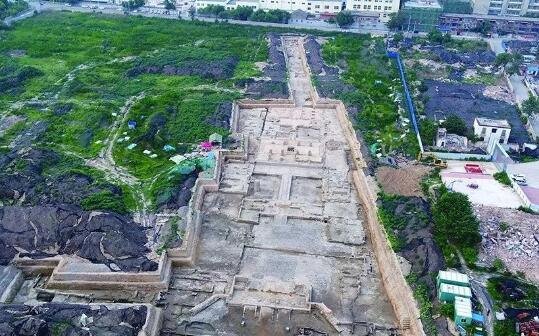
Aerial photo of the site
Features
The gate (F9), about 19.7 meters in width and 8.8 meters in length with two partitions, was a house-like construction on a platform, with five rooms and three doors. The roof of the construction was made of green glazed tiles, imbrices and dripping tiles with dragon pattern.
The etiquette door, 12.8 meters in width and 8.6 meters in length with two partitions, was a house-like construction on a platform, with three rooms and one door. There were gate houses in the northern, eastern and western parts. To the north of the etiquette door, a hallway (L1) on the platform, about 3.2 meters wide and 0.8 meter high, opened onto the platform of the front hall. The hallway was paved with blue slabs along the halfway line and edges, and blue tiles mingled in the middle.
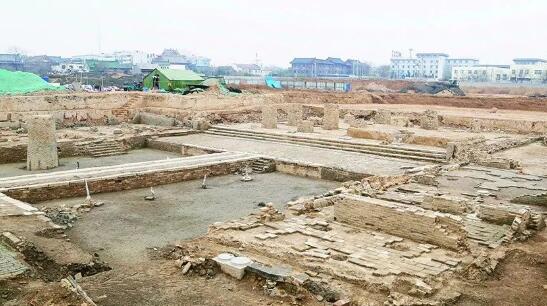
The terrace and hallway
The east and west wings (F2 and F3) of the front hall along both sides of the hallway were also constructions on a platform. The room in the west wing was 19.7 meters in width with five partitions and 9.4 meters in length with two partitions, while the one in the east wing was 20 meters in width with five partitions and 8.9 meters in length with two partitions. There were five steps respectively in front of the outer rooms in both wings leading to the courtyard.
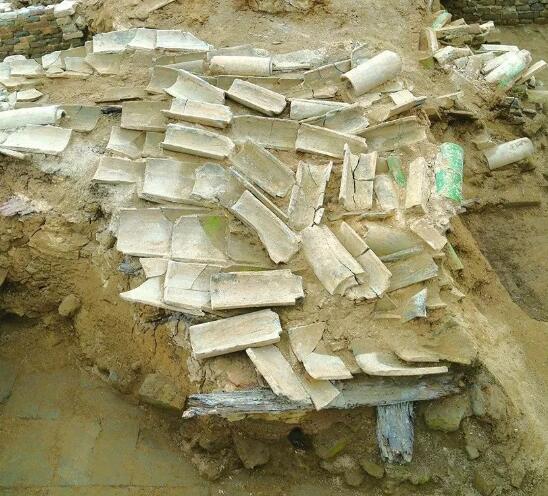
The collapse rooftop
The front hall (F1), as the largest building with the most luxurious decoration within the Lord’s Mansion, was 24.7 meters in width with five partitions and 19.8 meters in length with three partitions, inside of which almost half of the entire room was of Qing Dynasty-based construction intervened, with only a few bricks paved on the floor without any intervention. It could be inferred from the accumulated architectural compositions around that the roof of the house was made of green glazed tiles, imbrices and dripping tiles with dragon pattern. A tomb (M1) was found in the outer room of the front hall in the north of the center paved with square bricks, with two sets of skeletons inside two coffins cleared. A cooper mirror, two a few copper coins and two copper badges were found in the east coffin, while a copper pin, some pearls and several strings of coral beads were found in the west coffin. The owner of the east coffin was identified as a man died at an age between 35 to 40 years old. And the owner of the west coffin was a woman died at an age between 50 to 55 years old.
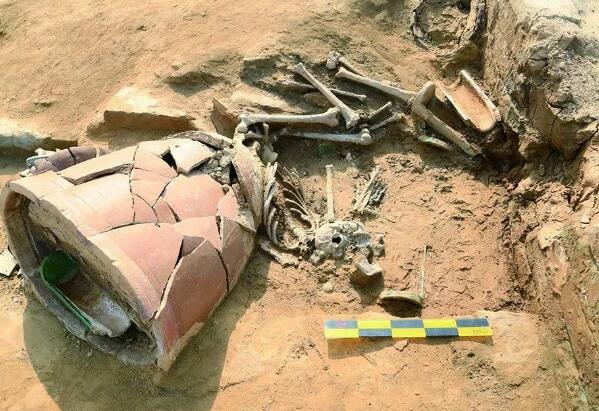
The sekelton in front of the main gate
The east and west wings (F4 and F5) of the back hall (F10) was severely destroyed by the intervention. The back hall with the base and a few bricks left only, was about 24.7 meters in width with five partitions and 13.5 meters in length with three partitions. The platform in front of the hall was 13.4 meters long, 6 meters wide and 0.8 meters high. In the south of the platform, there was a hallway (L2) on the platform leading to the front hall. Severe intervention was found in the rooms along both sides of the hallway attached to the east and west wings.
A rockery piled with layers of grey soil about 12 meters away from the north of the back hall remained about five meters high. In the north slope of the rockery, there was a square pool, about 5.8 meters long from north to south, 4.7 meters wide from east to west, and 1-1.3 meters deep. There was the northern wall of the Lord’s Mansion to the northernmost of the rockery.
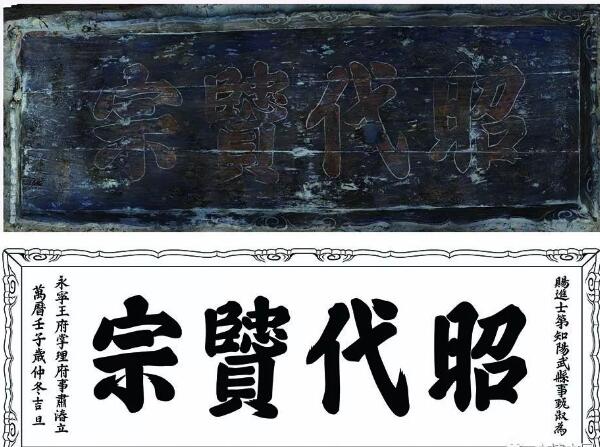
The horizontal inscribed board
On top of the two sets of skeletons in M1 of the front hall, 13 sets more were successively found in somewhere else at the Site, which was of various gestures with features of abnormal death.
Relics unearthed at the Site were mainly daily necessities, architectural compositions and ritual wares, more than 1,600 pieces (sets) in total, including potteries, ceramics, stone wares, articles made of jade, gold, silver, copper, tin, colored glaze, wood, bones, horns, shells. A wooden plaque “昭代贤宗” (Virtuous Tribe of the Good Time) written in regular script was unearthed in front of the doorstep in the south.
Academic Significance
A Site of Explicit Feature The building codes and size of the Site, the use of green glazed composition, and the wooden plague written “昭代贤宗” (Virtuous Tribe of the Good Time) of the 40th year during the Wanli time showed that the Site should be the ruins of Lord Yongning’s Mansion in vassal state Zhou of the Ming Dynasty.
A Site of Remarkable Value Compounds on the central axis at the Site with a clear distribution in a large and high-rank architectural scale was the best-preserved excavated Prefecture Lord’s mansion of Ming Dynasty with most relics in China and the only Prefecture Lord’s mansion built by the regulation of early Ming Dynasty. Excavation of the Mansion is of great importance for research in the regulation of Prefecture Lord’s mansion of the Ming Dynasty. (Translator: Yuan Yuan)

